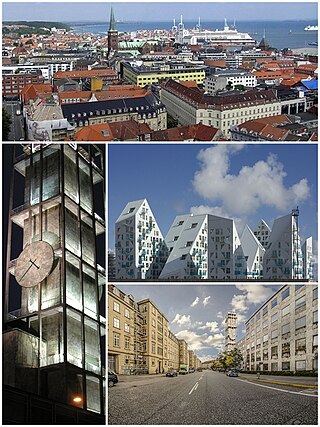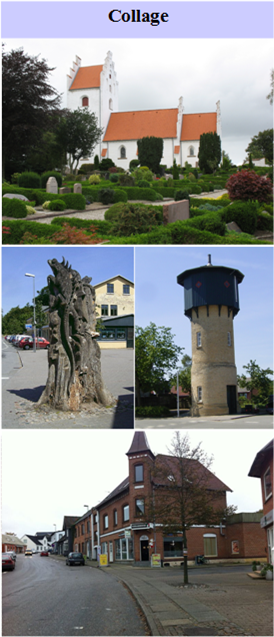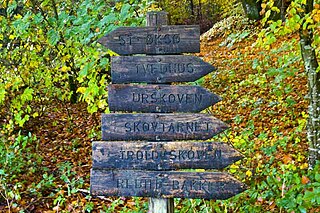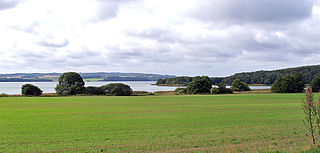
Aarhus is the second-largest city in Denmark and the seat of Aarhus Municipality. It is located on the eastern shore of Jutland in the Kattegat sea and approximately 187 kilometres (116 mi) northwest of Copenhagen.

Bastille Day is the common name given in English-speaking countries to the national day of France, which is celebrated on 14 July each year. In French, it is formally called the Fête nationale française ; legally it is known as le 14 juillet.

Skørping is a railway town in Rebild Municipality in Region Nordjylland in the geographic region of the Jutland peninsula known as Himmerland in northern Denmark. The modern town has a population of 3,043 as of 1 January 2023.

Independence Day, known colloquially as the Fourth of July, is a federal holiday in the United States commemorating the Declaration of Independence, which was ratified by the Second Continental Congress on July 4, 1776, establishing the United States of America.
National Hispanic Heritage Month is annually celebrated from September 15 to October 15 in the United States for recognizing the contributions and influence of Hispanic Americans to the history, culture, and achievements of the United States.

Rebild Municipality is a kommune in the North Jutland Region of Denmark. It covers an area of 628 km² and has a total population of 30,908 (2023).

The Swiss National Day is the national holiday of Switzerland, set on 1 August. Although the founding of the Swiss Confederacy was first celebrated on this date in 1891 and annually since 1899, it has only been an official holiday since 1994.

Rold Skov is a forest in Himmerland, Denmark. At 8,000 ha, it is the second largest forest in the country, after the Silkeborg Forests.

The Danish Realm, officially the Kingdom of Denmark, is the area over which the monarch of Denmark is head of state. It consists of metropolitan Denmark—the kingdom's territory in continental Europe and sometimes called "Denmark proper" —and the realm's two autonomous regions: the Faroe Islands in North Atlantic and Greenland in North America. The relationship between the three parts of the Kingdom is also known as The unity of the Realm.

Søndermarken is a park in Frederiksberg on the border to Valby and the Carlsberg area in Copenhagen, Denmark. It shares much of its history with Frederiksberg Gardens from which it is separated only by Roskildevej. Cisternerne—an underground venue for art exhibitions in the former cisterns—are located inside the park.

Georg John Lober was an American sculptor best known for his 1959 statue of composer George M. Cohan situated in Times Square, a 1949 sculpture of statesman Thomas Paine in Morristown, New Jersey, and a bronze sculpture of Danish writer Hans Christian Andersen located in Central Park, Manhattan. He served for nearly two decades as executive secretary for the New York City Municipal Art Commission, from 1943 to 1960.

Herning is a Danish town in the Central Denmark Region of the Jutland peninsula. It is the main town and the administrative seat of Herning Municipality. Herning has a population of 51,193 including the suburbs of Tjørring, Snejbjerg, Lind, Birk, Hammerum, and Gjellerup, making Herning the 11th most populous urban area in Denmark.

Max Henius was a Danish-American biochemist who specialized in the fermentation processes. Max Henius co-founded the American Academy of Brewing in Chicago.

Rebild National Park is a protected area located in Rebild municipality in Region Nordjylland in Denmark.
Events from the year 1912 in Denmark.

The Petrillo Music Shell is an outdoor amphitheater in Grant Park in the Loop community area of Chicago in Cook County, Illinois, United States. It serves as host to many large annual music festivals in the city such as Chicago Blues Festival, Chicago Jazz Festival, Taste of Chicago and Lollapalooza.

Mossø is Denmark's third largest freshwater lake and Jutland's largest, as measured by surface area. The lake is located just west of the city of Skanderborg in east Jutland, but is part of both Skanderborg Municipality and Horsens Municipality. Mossø lies in the middle of the area and landscape known as Søhøjlandet.

The Danish National Exhibition of 1909 or The National Exhibition in Aarhus 1909 was an industry, crafts and culture exhibition held in Aarhus, Denmark in 1909 from 18 May to 3 October. The exhibition displayed some 1850 individual works by architects, artists, craftsmen and businesses and attracted 650.000 visitors. The project was a large undertaking for the city with long-lasting effects on cultural institutions and short-term economic problems. The exhibition fairgrounds was named The white City based on the architectural expression chosen by the leading architect Anton Rosen.


















